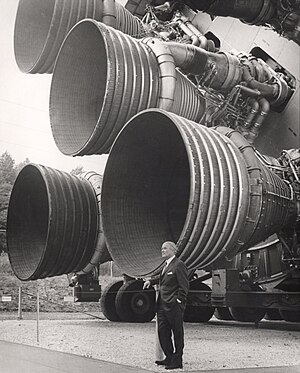Saturn V
Saturn V was the launch vehicle used by NASA in the Apollo program. The Saturn V carried Apollo 11 to the Moon in 1969, after years of trial, study, and research into its design. Much of the rocket was designed by German engineer and scientist Wernher von Braun, who had previously created the V2 rocket under Nazi Germany. 32 Saturn-model rockets were sent up into space in total, with the launches split between the smaller Saturn I, and its bigger sibling, the Saturn V.[4] 15 Saturn V rockets were made, and 13 were sent up to space for missions.[4] There were two Saturn V's launched with no people in them, used as 'dress rehearsals', with the first manned Apollo flight using a Saturn V being Apollo 8, which was sent around the Moon on December 21, 1968.[5]
 The Saturn V rocket carrying the Apollo 11's three people into space. | |
| Function |
|
|---|---|
| Manufacturer | |
| Country of origin | United States |
| Project cost | $6.417 billion in 1964–1973 dollars (~$42 billion in 2018 dollars) |
| Cost per launch | $185 million in 1969–1971 dollars[1] ($1.16 billion in 2016 value), of which $110 million was for vehicle.[2] |
| Size | |
| Height | 363.0 ft (110.6 m) |
| Diameter | 33.0 ft (10.1 m) |
| Mass | 6,540,000 lb (2,970,000 kg)[3] |
| Stages | 2-3 |
| Capacity | |
| Payload to TLI | 107,100 lb (48,600 kg)[3] |
| Associated rockets | |
| Family | Saturn |
| Derivatives | Saturn INT-21 |
| Comparable |
|
| Launch history | |
| Status | Retired |
| Launch sites | Kennedy LC-39 |
| Total launches | 13 |
| Successes | 12 |
| Failures | 0 |
| Partial failures | 1 (Apollo 6) |
| First flight | November 9, 1967 (AS-501 Apollo 4) |
| Last flight | May 14, 1973 (AS-513 Skylab) |
| Template:Infobox rocket/Stage Template:Infobox rocket/Stage | |
The Saturn V rocket was a three-part machine. It stood 111 metres (363 feet) high and weighed 2,903,020 kilograms (6,400,060 pounds). The first rockets were able to carry 44,600 kilograms (98,300 pounds), which went up to 46,800 kilograms (103,200 pounds) for the later Apollo flights.[4] The first and second stages gave the power needed to lift the rocket off of Earth, intended to break through the atmosphere, so that the weaker third stage could go the rest of the way. The first and second stages each had five engines. The first stage burned kerosene and liquid oxygen together, with the other stages burning a mixture of liquid oxygen and liquid hydrogen.[4]
The first stage engines burned for 168 seconds and was able to lift Apollo about 93 kilometres (58 miles) off of from the launch pad. The second stage burned for about 8 minutes, in order to take Apollo through the upper atmosphere. By this time, it was traveling at 25,182 kilometres per hour (15,647 miles per hour).
The third stage was used for 2 minutes and 30 seconds to put Apollo into an Earth orbit. This was at a height of 191.2 kilometres (118.8 miles) above the Earth. The third stage was started again and burned for 6 minutes to make the speed go up to 40,320 kilometres per hour (25,050 miles per hour) needed to send Apollo off to the Moon.[5]
Saturn V Media
This photograph was taken during the final assembly operation of the Saturn V launch vehicle for the Apollo 4 (SA 501) mission. The instrument unit (IU) was hoisted to be mated to the S-IC/S-II assembly in the Vehicle Assembly Building high bay at the Kennedy Space Center.Note that the access door has been removed (about 8 o'clock), to allow technicians to enter the IU after it is stacked.
Condensation clouds surrounding the Apollo 11 Saturn V as it works its way through the dense lower atmosphere
A 70mm Airborne Lightweight Optical Tracking System (ALOTS) camera, mounted in a pod on a cargo door of a U.S. Air Force EC-135N aircraft, photographed this event in the early moments of the Apollo 11 launch. The mated Apollo spacecraft and Saturn V second (S-II) and third (S-IVB) stages pull away from the expended first (S-1C) stage. Separation occurred at a
Related pages
Notes
References
- ↑ "SP-4221 The Space Shuttle Decision- Chapter 6: Economics and the Shuttle". NASA. Retrieved 2011-01-15.
- ↑ "sp4206".
- ↑ 3.0 3.1 "Ground Ignition Weights". NASA.gov. Retrieved November 8, 2014.
- ↑ 4.0 4.1 4.2 4.3 "Saturn V: America's Moon Rocket". airandspace.si.edu. 2007. Archived from the original on 29 August 2012. Retrieved 12 August 2012.
- ↑ 5.0 5.1 Furniss, Tim (2001). The History of Space Vehicles. London: Grange Books. ISBN 1-84013-370-8.
Other websites
NASA sites
- Three Saturn Vs on Display Teach Lessons in Space History Archived 2019-06-23 at the Wayback Machine
- Apollo Lunar Surface Journal Archived 2020-12-31 at the Wayback Machine
- Declassified 1964 NASA technical memo on Saturn Rockets Note that this is a large PDF file (61 Megabytes)
- Launch complex 39 facility description from 1966 (10 Megabyte PDF file)
- Exploring the Unknown Selected Documents in the History of the U.S. Civil Space Program
